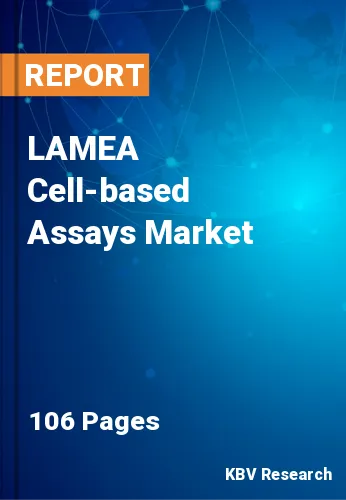
The Latin America, Middle East and Africa Cell-based Assays Market would witness market growth of 11.4% CAGR during the forecast period (2022-2028).
HCS enables the automated detection of modifiers of accessible as well as biologically relevant targets. As a result, it can be used to detect gene interactions or find hazardous pathways of drug candidates, both of which are useful in improving the processes of drug discovery and development. These assays include immunohistochemistry, reporter gene assay, RNAi, CRISPR-Cas9 system, and protein-protein interactions.
These assays are used to evaluate a wide range of cellular processes, such as protein expression, proliferation, morphological changes, localization, post-translational modifications, as well as protein-protein interactions. These cell-based assay techniques can be applied to both 2D and 3D cell culture systems in a high-throughput way. Additionally, these methods can be used with either primary or secondary cultures.
In recent years, there has been a significant increase in demand for cell-based assays. This can be attributed to the rise in cell-based applications in drug development as well as the technological breakthroughs that have been made in the methodologies used for cell-based assays. The rise in the prevalence of lifestyle disorders, like arthritis, cancer, diabetes, epilepsy, cardiovascular diseases, and many others, which still have considerable unmet requirements and have prompted continuous expenditures in R&D, is another significant driver that drives market expansion.
This market is also being pushed by a growth in the use of cell-based assay methodologies for high throughput screening procedures, such as toxicity research, in-vitro testing, drug screening, and a variety of other types of testing, among other things. The use of high-throughput screening technologies and an increase in spending on research and development are both contributing factors that are driving the market.
The stem cell is an emerging field of research in South Africa, with a number of public as well as private research institutes shifting their focus toward the sector. Both communicable diseases (infectious diseases, such as Tuberculosis/TB), as well as non-communicable diseases, are being researched by the Stem Cell Research and Therapy Unit in South Africa in an effort to find strategies to reduce the country's overall infection incidence. Both the law and ethical considerations must be taken into account prior to and during the process of using stem cells in medical research and treatment protocols. In this aspect, the law and medical ethics go hand in hand with each other.
The Brazil market dominated the LAMEA Cell-based Assays Market by Country in 2021, and would continue to be a dominant market till 2028; thereby, achieving a market value of $413.9 Million by 2028, growing at a CAGR of 10.3 % during the forecast period. The Argentina market is showcasing a CAGR of 12% during (2022 - 2028). Additionally, The UAE market would register a CAGR of 11.1% during (2022 - 2028).
Based on Application, the market is segmented into Drug Discovery, Basic Research and Others. Based on End User, the market is segmented into Pharmaceutical & Biotechnology Companies, Academic & Research Institutes and Contract Research Organizations (CROs). Based on Products & Services, the market is segmented into Assay Kits, Reagents, Microplates, Probes & Labels, Instruments & Software and Cell Lines. Based on countries, the market is segmented into Brazil, Argentina, UAE, Saudi Arabia, South Africa, Nigeria, and Rest of LAMEA.
0Free Valuable Insights: The Global Cell-based Assays Market is Predict to reach $24.9 Billion by 2028, at a CAGR of 8.2%
The market research report covers the analysis of key stake holders of the market. Key companies profiled in the report include Becton, Dickinson and Company, Bio-Rad Laboratories, Inc., Corning Incorporated, Charles River Laboratories International, Inc., Danaher Corporation, F. Hoffmann-La Roche Ltd., Lonza Group AG, Merck Group, Promega Corporation and Thermo Fisher Scientific, Inc.
By Application
By End User
By Products & Services
By Country
Our team of dedicated experts can provide you with attractive expansion opportunities for your business.
